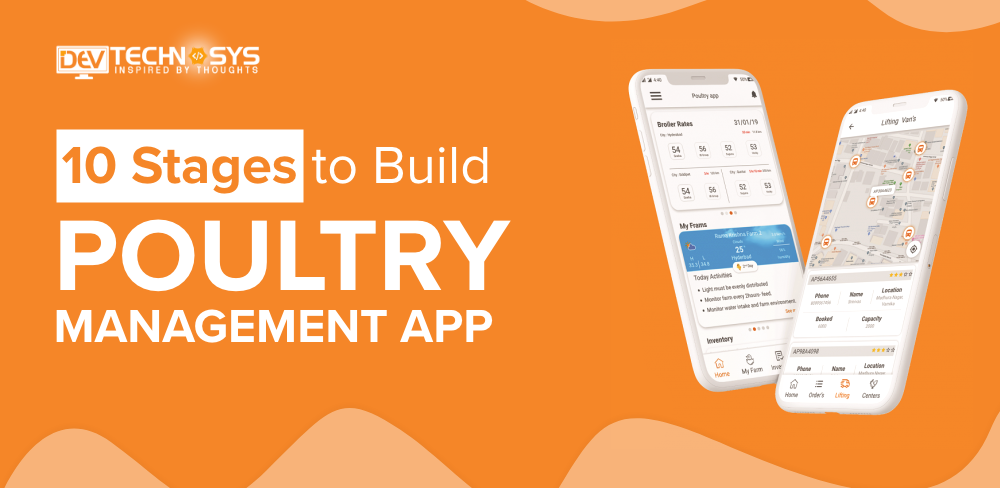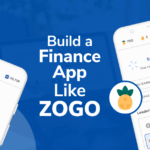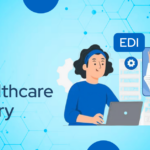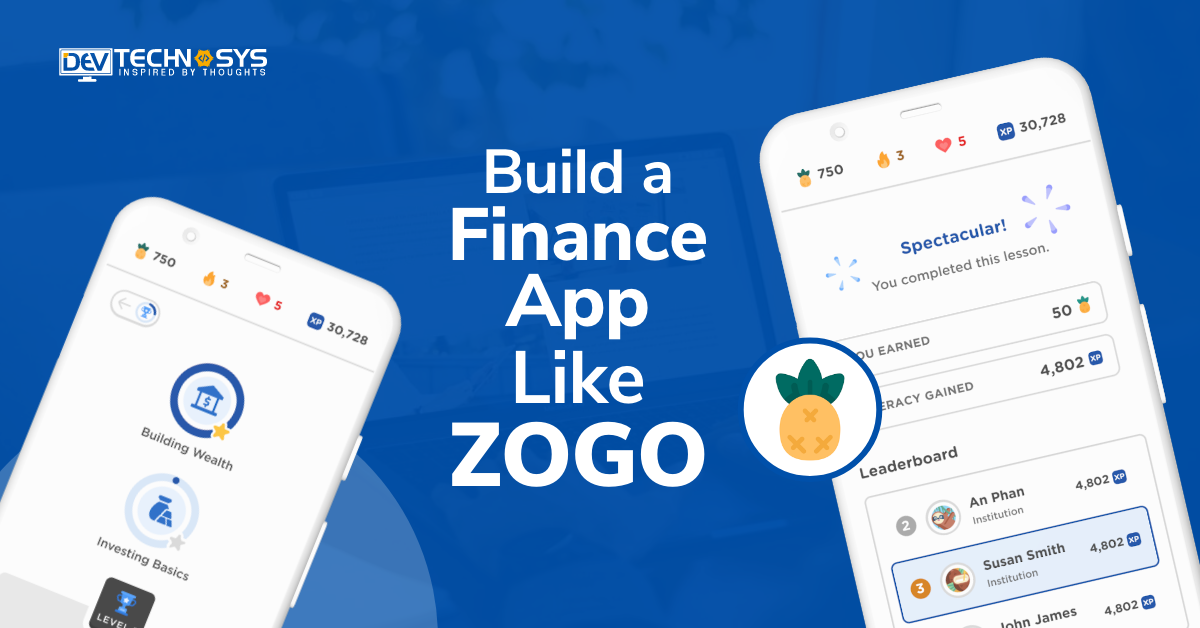We are surrounded by technology in every aspect of our lives. With mobile apps and technology, various industries, including healthcare, entertainment, and poultry farming, have become more promising. As a result of technological advancements and various mobile applications, one can quickly learn about global developments from another part of the world.
Poultry is a major contributor to global food production, and there is an increasing demand for poultry products. However, the poultry production process is complex and requires a lot of skill and knowledge.
To meet the rising demand for poultry products, it is necessary to build poultry management apps to help farmers and poultry producers manage their farms more efficiently.
It is a great way to improve operations and increase efficiency. An app allows you to track and monitor your birds in real time, making more informed decisions about their care.
Due to the immense popularity of on demand mobile app development, more businesses are planning to develop poultry management applications.
Hence, the demand for a poultry management app development company has risen to a great extent. Are you also one of those who want to build poultry management apps for your business? Then you have reached the correct place.
In this blog, we will discuss how to build poultry management apps. Also, what features you must integrate into your app to compete in the marketplace?
So let’s start the blog.
Table of Contents
Market Stats of Poultry Management
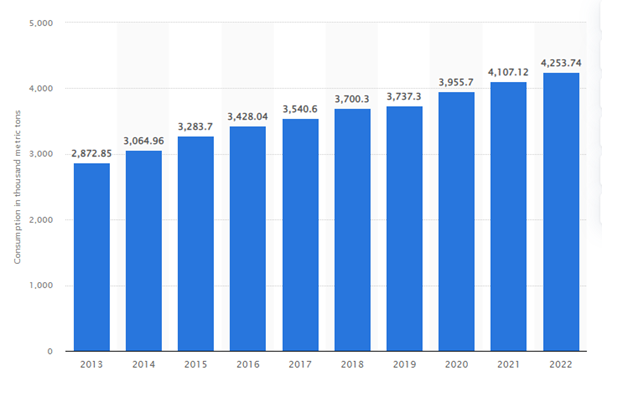
- Over 539 million heads of poultry, particularly important for the production of meat and eggs, were present in Russia in 2021, an increase of about 19 million heads from the year before. By 2021, the stockpile would have expanded by more than 196 million heads compared to the figure from 2003.
- Over 539 million heads of poultry, particularly important for the production of meat and eggs, were present in Russia in 2021, an increase of about 19 million heads from the year before. By 2021, the stockpile would have expanded by more than 196 million heads compared to the figure from 2003.
- With sales of 13.4 billion dollars, chicken was the second most often purchased fresh meat category.
- With an inventory of more than 224 million turkeys and 518 million chickens, the poultry business in the US is thriving. Production of chicken increased to almost 44 billion pounds in 2019.
What is a Poultry Management App?

A poultry management app is a software application that helps farmers and poultry owners manage their flocks by providing tools for tracking bird health, feed and water consumption, egg production, and other important aspects of poultry farming. It can also provide alerts and notifications for important events, such as when a bird is sick, or eggs are ready to be collected.
Features of Poultry Management App
Poultry management apps are designed to assist farmers and poultry owners in managing and monitoring their flocks. These apps typically include various features to help users track their birds’ health, growth, and overall performance. Here are the features of poultry management apps include:
- Sign up
It allows users to sign in with their social media accounts by putting all the necessary details. It includes the contact number, name, email id, etc.
- Flock Tracking
This feature allows users to keep track of their birds’ information, such as breed, age, weight, and health status. Users can also record data on feed consumption, egg production, and other key metrics.
- Health Monitoring
Poultry management apps often include tools to help users monitor their birds’ health, such as symptom checklists, vaccination records, and alerts for signs of illness. To integrate this feature into your app, you must hire dedicated developers.
- Feed Management
These apps may include features to help farmers manage their birds’ feed, such as feed consumption tracking, feed inventory management, and alerts for low feed levels.
- Egg Tracking
This feature will help users track egg production, including the number of eggs laid, the weight of each egg, and the eggs’ size and quality.
- Alerts and Notifications
This app often includes notifications for important events, such as when a bird is due for a vaccination or low feed levels. Users can also set up custom alerts for specific events, such as when a bird appears ill.
- Reporting and Analytics
Poultry management apps often include reporting and analytics tools to help users track the performance of their flocks over time, such as egg production rate, feed consumption, and health status.
- Data Backup
Users will have the feature of data backup that ensures that all data stored in the app is backed up regularly on the cloud and can be retrieved in case of any emergency.
- Multi-user Access
This app allows multiple users to access and update the data simultaneously, which is useful for farmers who work with a team.
- Integration with other Tools
With this feature, users can integrate their app with other tools and systems, such as weather forecasting apps, to provide farmers with more detailed information on the environment their birds are living in.
- Mobile Accessibility
Poultry management apps are usually available for Android and iOS platforms, making it easier for farmers to access the app from anywhere and at any time.
10 Stages to Build Poultry Management App
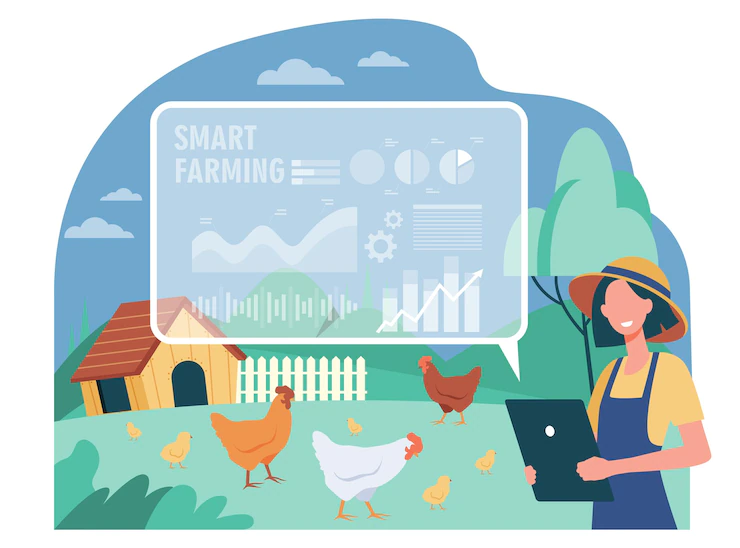
Now that you are familiar with the features of the poultry management app, it is time to build poultry management apps. So let’s have a look at each step in detail.
1. Define the Project Scope and Objectives
Defining the project scope and objectives is the first stage in building a poultry management app. It entails establishing the precise objectives and specifications for the app, as well as what features it will include and how poultry farmers will utilize it.
It is crucial to have a clear grasp of the project scope to ensure that the development process stays on track and that the finished product satisfies the target audience’s needs. This step also entails figuring out the project’s budget and resources needed, as well as the development schedule.
2. Research and Gather Information
Researching and gathering data on chicken management is the next step to building poultry management apps. It entails researching the techniques, trends, and technology currently used in the poultry sector and pinpointing the requirements and difficulties poultry producers face.
The research will inform the design and development of the poultry farm management app, which will also assist in identifying potential features that farmers will find useful and advantageous. This phase is crucial to ensure the app is meeting the actual demands of the target audience and giving them information that is pertinent and helpful.
3. Identify the Target Audience and Their Needs
The third step in developing a poultry management app is determining the target market and its requirements. Knowing the characteristics, tastes, and routines of the farmers who will use the app is crucial, according to the research done in the previous step.
The target market will provide input into the design and development of the app, assisting in its customization to its users’ unique requirements and expectations. It will also be helpful to prioritize the development process by identifying the features and functionalities that the target audience values the most.
It is possible to develop a user-friendly poultry feed calculator app that is easy and simple for the intended use by determining the target demographic.
4. Create a Wireframe or Prototype of the App
Creating a wireframe or prototype for the app is the fourth phase of building poultry management apps. An app’s layout and design are represented visually in a wireframe, which makes it easier to explain how the app will work and how users will interact with it.
It acts as a development roadmap for the app and aids in spotting any potential issues or difficulties before the real development process starts. On the other hand, a prototype is a working representation of the app that enables consumers to engage with it and offer feedback.
It is useful for confirming the app’s design, usability, and user experience. This stage is essential to ensure the app is easy to use and navigate and that the features are properly arranged and simple for users to reach.
5. Develop the UI/UX
Creating the user interface and experience is the fifth step in building a poultry management app. This step entails developing the app’s visual style and structure and adding the functionality and features mentioned in the preceding sections.
It is crucial to check that the app’s UI is clear, aesthetically beautiful, user-friendly, and easy to navigate. For this step, you must hire an experienced mobile application development company to design and build poultry management apps.
The app should be suitable for different devices and screen sizes, and the user experience should be fluid and effective. This process is crucial because testing predicts how users will interact with the app and help find any bugs or issues that developers need to fix before releasing the app.
6. Integrate Features in the App
Integrating features like data entry, tracking, and reporting is the sixth phase of creating a poultry management app. You can implement the functions that will enable users to input, save, and retrieve information about their poultry farming operations.
You can track a poultry farm’s performance monitor using tools like report generation and data analysis. This phase is crucial because it allows farmers to understand their operations better, govern them, and make decisions based on data-driven insights. It can also assist farmers in locating and resolving any problems that might develop on the farm.
Everything You Need To Know About Mobile App Development Process
7. Test the App for Functionality and Usability
The seventh stage of developing a poultry management app is testing the usability and functionality of the program. It is crucial to finish this stage to ensure that the app is operating as intended and error-free.
Additionally, it helps identify any usability issues or places where the app’s design has to be enhanced. Quality Analysts can apply several strategies during the testing process, including unit testing, integration testing, and user acceptability testing.
The app is thoroughly tested across various hardware and software platforms at this step, and any issues are identified and rectified. Developers must complete this stage to ensure that the app is stable before deployment.
8. Implement Any Necessary Changes or Revisions
Implementing essential alterations or revisions is the eighth phase of building poultry management apps. This step is based on the testing procedure’s findings in the preceding stage.
Any problems or defects found during testing are resolved, and any recommendations for enhancements are added to the program.
This process also includes making any modifications or revisions needed to fulfill the goals of the app and the requirements of the intended user base.
After making these adjustments, it is crucial to thoroughly test the app once more to ensure that the problems have been fixed and that it is operating as intended. Prior to launch, this stage is essential to ensuring that the app is of good quality and satisfies user expectations.
9. Launch the App and Gather Feedback from Users
Launching the app and getting user feedback is the ninth phase in developing a poultry management app. The app is ready to be released and made accessible to the intended audience once it has been finished and tested.
This step entails making the app accessible to users via app stores or the company website. After the app launches, it’s critical to collect user feedback to understand how users use it and spot any problems or potential improvement areas.
This step is crucial to gauge the effectiveness of the app and pinpoint any areas that require more development, so hire Indian coders who are economical and best in their field. Additionally, it aids in enhancing user pleasure and raising the likelihood that the app will succeed.
10. Maintenance and updates
Updating and maintaining an app for managing poultry is the final step in the process. This action is essential to maintaining the app’s functionality and applicability. It entails correcting any problems or errors that might appear and updating the app with fresh features and functions.
It also includes routinely checking the app’s security and functionality to ensure both are functioning properly and user data is secure.
This step is continual and requires ongoing resources to manage the app and keep it up to the consumers’ expectations so they will continue to use it and suggest it to others.
Conclusion
A poultry management app can aid farmers and producers in keeping track of their poultry inventory, feed and medication schedules, and financial records.
It can also provide useful information such as weather forecasts and market prices. However, the development of such an app can improve efficiency and productivity in the poultry industry. Also, it can be highly advantageous.
Now that you have understood everything there is to ascertain about poultry management app development, it’s time to implement your ideas into action.
So, get in touch with a leading mobile app development company that can provide the best android application development services to build poultry management apps and help your business reach greater heights.
Frequently Asked Questions
What are all the Benefits of the Poultry Management App?
Poultry management apps can help farmers track and manage their poultry operations, including feed and water usage etc. These apps can also provide analytics, reporting and forecasting, which can help farmers make better decisions for their poultry farming business.
Which is the Best Poultry Management App?
Several poultry management apps are available on the market, and the best one for you will depend on your specific needs. Some popular poultry management apps include FarmLogs, My Poultry Manager app, PoultryPal, Poultry Keeper, AgroStar and Poultry Nucleus.
How Much Does it Cost to Convert a Poultry Management Website into a Mobile App?
The cost to convert a poultry management website into a mobile app can vary depending on the website’s complexity and the features needed in the app. Factors including the number of pages, the amount of data, and the platform type will all affect the cost. Typically, it can range anywhere from $25,000 – $50,000 or more, depending on the complexity and features required.

